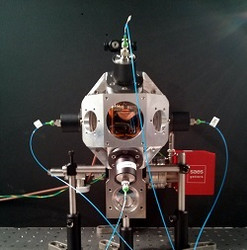Ultra-sensitive cold atom quantum sensors to advance geophysics and computing
Cold atom technology is not yet used in real-world applications. The EU-funded ISENSE(opens in new window) project aims at changing this with novel technologies integrated into a single system and demonstrated in a cold atom quantum sensor device. Quantum sensors use advanced quantum effects, like superposition, to achieve ultra-high levels of sensitivity (going beyond the one of a classical device). An atom can be simultaneously in two internal energy states (superposition) which means that atoms travel along two paths of different heights – allowing scientists to build ultra-sensitive gravity sensors. Cold atom devices can achieve ultimate control over the position, velocity and internal states of atoms using light-atom interaction techniques. ‘Once the atoms are cooled to a millionth of a degree above absolute zero, they become perfect probe particles for quantum sensors. The sensing of time, gravity, rotations and magnetic fields has been demonstrated in a laboratory with record-setting sensitivity,’ Professor Kai Bongs of the University of Birmingham, UK, and ISENSE project coordinator, explains. ‘iSense technology opens up the potential for a mobile and absolute gravimeter at a higher sensitivity' he adds. If atoms are cooled further, they become a degenerate quantum gas which could potentially be used in quantum computing. While such technology has already been demonstrated, ISENSE is taking it one step further by integrating all components needed for a cold atom quantum sensor into one mobile system. ‘This is a key step in translating science into a commercial technology which can impact everybody’s life,’ Bongs says. ISENSE developed cold atom quantum technology using lasers, optical delivery, electronic control, vacuum and low-power atom chip technology. These technologies were then integrated into a gravity sensor device to demonstrate their functionality. Translation to the market The project successfully managed to demonstrate the ISENSE quantum sensor in Brussels. This allowed the project to gain wider industry interest for quantum technology. ‘Industry realised that there is a real practical opportunity here. Now, over 70 companies are supporting the UK National Quantum Technology Hub in Sensors and Metrology, which is now carrying out the next steps in developing our technologies,’ Bongs explains. Once available commercially, ultra-sensitive, mobile gravity sensor devices could revolutionise geophysics like ground water mapping, assessing volcano and earthquake activity, assessing building sites for underground sinkholes and locating underground pipes. Currently, the need to dig to examine for holes and sinks costs the EU economy billions of Euros a year. The technology platform developed by ISENSE can be used in any cold atom device. This includes quantum sensors, quantum simulators, quantum memories for quantum communication and quantum computers. The closest to market technology is quantum sensors, in particular for gravity, time, rotation and magnetic fields.







